My Force 6000e
Tarsus, Mersin
City in Turkey
District in Mersin, Turkey
Tarsus (; Hittite: 𒋫𒅈𒊭 Tārša; Greek: ΤαρσόςTarsós; Armenian: ՏարսոնTarson; Arabic: طَرسُوسṬarsūs) is a historic city in south-central Turkey, 20 km (12 miles) inland from the Mediterranean. It is part of the Adana-Mersin metropolitan area, the fourth-largest metropolitan area in Turkey. Tarsus forms an administrative district in the eastern part of Mersin Province and lies at the heart of the Çukurova region.
With a history going back over 6,000 years, Tarsus has long been an important stop for traders and a focal point of many civilisations. During the Roman Empire, it was the capital of the province of Cilicia. It was the scene of the first meeting between Mark Antony and Cleopatra, and the birthplace of St Paul the Apostle.
Tarsus is served by Adana Şakirpaşa Airport and is connected by Turkish State Railways to both Adana and Mersin.
Etymology[edit]
The ancient name Tarsos is derived from Tarsa, the original name given to the city by the Hittites, who were among the earliest settlers of the region. That in turn was possibly derived from the name of the storm god Tarḫunz.[2] During the Hellenistic era Tarsus was known as Antiochia on the Cydnus (Greek: Αντιόχεια του Κύδνου, Latin: Antiochia ad Cydnum), to distinguish it from Syrian Antioch. The Romans knew it as Juliopolis, while it was Darson in Western Armenian and Tarson in Eastern Armenian.
According to the Suda, the city was founded by Perseus after he fought the Isaurians and the Cilicians. An oracle told him to found a city in the place where the flat (ταρσός) of his foot would touch the earth while he was dismounting from his horse after the victory.[3]
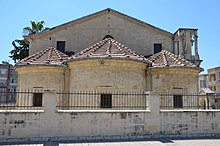
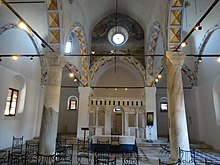
Geography[edit]
Located on the mouth of the Berdan River (Cydnus in antiquity), which empties into the Mediterranean, Tarsus sits at a junction where land and sea routes connecting the Cilician plain (today called Çukurova), central Anatolia and the Mediterranean Sea meet. The climate is typical of the Mediterranean region, with very hot, humid summers and chilly, damp winters.
Tarsus has a long history of commerce, and is still a commercial centre today, trading in the produce of the fertile Çukurova plain. Tarsus is also a thriving industrial centre for refining and processing for export. Industries include agricultural machinery, spare parts, textiles, fruit-processing, brick-making and ceramics.
Agriculture is an important source of income with half the local land area farmland (1,050 km2 [410 sq mi]) and most of the remainder forest or orchard. The farmland is mostly well-irrigated, fertilised and managed with up-to-date equipment.
History[edit]

Foundation and prehistory[edit]
Excavation of the mound of Gözlükule revealed that the prehistoric development of Tarsus reached back to the Neolithic Period and continued unbroken through the Chalcolithic and Early Bronze Ages.
The settlement stood at the crossing of several important trade routes linking Anatolia to Syria and beyond. Because most of the ruins lie under the modern city, archaeology has barely touched the ancient city. As an important port in a merchant marine trade network spanning the eastern Mediterranean and beyond from before the third millennium, the city was always an important centre for cultural interchange with traces of its influence visible from pre-Homeric Greek evidence onwards. The city may have been of Anatolian or Semitic origin; it is first mentioned as Tarsisi in Neo-Assyrian records of the campaigns of Esarhaddon, as well as several times in the records of Shalmaneser I and Sennacherib, the latter having had the city rebuilt. A Greek legend connects it with the memory of the Assyrian king Sardanapalus (Ashurbanipal), still preserved in the Dunuk-Tach, called 'tomb of Sardanapalus', a monument of unknown origin. During the Hellenistic era it was a centre for exchange between Neo-Platonic, Gnostic and Mystery traditions.
Stephanus of Byzantium quotes Athenodorus of Tarsus on another legend:
Anchiale, daughter of Iapetus, founded Anchiale (a city near Tarsus): her son was Cydnus, who gave his name to the river at Tarsus: the son of Cydnus was Parthenius, from whom the city was called Parthenia: afterwards the name was changed to Tarsus.
Much of this legendary account of the foundation of Tarsus, however, appeared in the Roman era, and it is not reliable. The geographer Strabo states that Tarsus was founded by people from Argos who were exploring this coast. Another legend claims that Bellerophon fell off his winged horse Pegasus here, hurting his foot in the process, and that the city was named tar-sos (the sole of the foot) in memory of his accident. Other candidates for legendary founder of the city include the hero Perseus and Triptolemus, son of the earth-goddess Demeter, doubtless because the countryside around Tarsus is such good farmland. Later the coins of Tarsus bore the image of Hercules due to another tale in which the hero was held prisoner here by the local god Sandon. Tarsus has been suggested as a possible site for the biblical Tarshish, to which the prophet Jonah wanted to flee, but Tartessos in Spain has also been offered as a possible location for this. (See further[4])
Early Antiquity, Greece and Persia[edit]
See also: Cilicia (satrapy)
In historical times, the city was first ruled by the Hittites, followed by Assyria, and then by the Persian Empire. As the principal town of Cilicia, Tarsus was the seat of a Persian satrapy from 400 BC onward. Indeed, Xenophon records that in 401 BC, when Cyrus the Younger marched against Babylon, the city was governed by King Syennesis in the name of the Persian monarch.
At this period the god of the city was Sandon, of whom a large monument existed at Tarsus at least until the 3rd century AD. Coins showed Sandon standing on a winged and horned lion, and it is now thought likely that the Lion of Saint Mark on the pillar in the Piazza San Marco in Venice was in origin a winged lion-griffin copied from such a monument in Tarsus.[5]
Alexander the Great passed through with his army in 333 BC and nearly met his death here after bathing in the Cydnus. By this time Tarsus was already largely influenced by Greek language and culture, and as part of the Seleucid Empire it became more and more Hellenised. Strabo praised the cultural level of Tarsus in this period with its philosophers, poets and linguists. The schools of Tarsus rivalled those of Athens and Alexandria. A reference in the Bible (2 Maccabees (4:30)) records the city's revolt against Antiochus IV Epiphanes in about 171 BC .The king had renamed the town Antiochia on the Cydnus although the name did not stick due because too many cities were named Antioch. At this time the library of Tarsus held 200,000 books, including a huge collection of scientific works.
Roman period[edit]
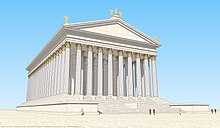

After crushing the feared Cilician pirates, Pompey brought Tarsus under Roman rule In 67 BC, and it became the capital of the Roman province of Cilicia.[6] To flatter Julius Caesar, it was briefly named Juliopolis. Cassius Longinus planned to kill him here as early as 47 BC, and Cleopatra and Mark Antony met and was the scene of the celebrated feasts they gave during the construction of their fleet (41 BC). In William Shakespeare's 1606 play Antony and Cleopatra (Act 5, Scene 2) Cleopatra says she is going to Cydnus to meet Antony after his death, (ishe will commit suicide to meet him in the afterlife). "Go fetch / My best attires: I am again for Cydnus, / To meet Mark Antony."
In the Roman period, the city was an important intellectual centre, boasting its own academy. One of its leading lights, the philosopher Athenodorus Cananites, was the tutor of the first Roman emperor, Augustus, a fact which secured continuous imperial patronage for the city.[6]
When the province of Cilicia was divided, Tarsus remained the civil and religious metropolis of Cilicia Prima, a grand city with palaces, marketplaces, roads and bridges, baths, fountains and waterworks, a gymnasium on the banks of the Cydnus, and a stadium. Tarsus was later eclipsed by nearby Adana but remained important as a port and shipyard. Several Roman emperors were interred here: Marcus Claudius Tacitus, Maximinus II and Julian the Apostate, who planned to move his capital here from Antioch if he returned from his Persian expedition.[7]
Christian and Byzantine eras[edit]
See also: Early centers of Christianity § Anatolia
Tarsus was the city where, according to the Acts of the Apostles, "Saul of Tarsus"[8] was born although he was "brought up"[9] in Jerusalem.[10] Paul was a Roman citizen (Acts 21:39; Acts 22: 25–29) "from Tarsus in Cilicia, a citizen of no ordinary city". Saul, who would eventually become Paul the Apostle after his professed encounter with Jesus (Acts21:39; 22:3 Acts.9:11;21:39;22:3 9Template:Bibleverse with invalid book), returned here after his conversion (Acts 9:30). About eight years later, Barnabas retrieved him from Tarsus to help with the work of preaching and teaching in Syrian Antioch (Acts 11:25).
By then, a Christian community probably already existed although the first recorded bishop, Helenus, dates only from the 3rd century. Owing to the importance of Tarsus, many martyrs were put to death there such as Saint Pelagia of Tarsus, Saint Boniface of Tarsus, Saint Marinus of Tarsus, Saint Diomedes, Saint Quiricus and Saint Julitta.
The city remained largely pagan, however, up to the time of Julian the Apostate (r. 361–363), who reportedly planned to make it his capital.[11] Following his death during his campaign against Sassanid Persia, he was buried next to the city walls, opposite the earlier tomb of the Tetrarch Maximinus Daia.[12] Emperor Justinian I (r. 527–565) undertook public works in the city, altering the course of the Cydnus river and rebuilding the bridge. Towards the end of his reign, the city suffered from riots stirred up by the Hippodrome Blues faction.[12]
A cave near Tarsus is one of several places said to be the location of the legend of the Seven Sleepers, common to Christianity and Islam.
Bishopric[edit]

The first recorded bishop of Tarsus, Helenus, went to Antioch several times in connection with the dispute concerning Paul of Samosata.[13]Le Quien[14] mentions twenty-two of its bishops, of whom several are legendary.
Tarsus was the metropolitan see of the province of Cilicia Prima, under the Patriarchate of Antioch.[14] From the 6th century onwards, the metropolitan see of Tarsus had seven suffragan bishoprics (Échos d'Orient, X, 145).
The Greek archdiocese, mentioned in the 10th century (Échos d'Orient, X, 98), has existed down to the present day as part of the Greek Orthodox Patriarchate of Antioch.[15]
At about the end of the 10th century, the Armenians established a diocese of their rite; Saint Nerses of Lambron was its most distinguished representative in the 12th century.
Tarsus is included in the Catholic Church's list of titular sees as a metropolitan see of both the Latin, the Maronite and the Melkite Catholic Church.[16]
[edit]
Middle Ages[edit]
Further information: Rashidun Caliphate, Umayyad Caliphate, Abbasid Caliphate, al-Qahir, al-Radi, Seljuk Sultanate, Sultanate of Rum, and Ayyubid dynasty
Following the Muslim conquest of the Levant in the 630s, the city came into contact with the forces of the Rashidun Caliphate. It is unclear when the town was first captured by the Arabs, but it is clear that it, and the wider region of Cilicia, remained contested between the Byzantines and the new Caliphate for several decades, up to the early 8th century. According to Muslim sources, as he was retreating the Byzantine emperor Heraclius (r. 610–641) deliberately withdrew the population and devastated the region between Antioch and Tarsus, creating a no man's land between the two empires.[21]
It was not until the early Abbasid period that Tarsus, by then lying in ruins, was reoccupied and refortified, this time as an advance strongpoint within the fortified zone of the al-ʿAwāṣim, stretching from Tarsus northeast to Malatya, and as an assembly point for expeditions against the Byzantine Empire.[22] The first attempt was undertaken by al-Hasan ibn Qahtaba al-Ta'i in 778/9 but was apparently unsuccessful and the city was not fully restored until 787/8, by Abu Sulaym Faraj on the orders of Caliph Harun al-Rashid (r. 786–809). Three thousand Khurasanis and 2,000 Syrians (a thousand each from Antioch and al-Massisa) were given houses and land in the new fortress city.[23] Tarsus was apparently recovered by the Byzantines soon after, at some point around the turn of the century. The city probably remained in Byzantine hands during the Abbasid civil war of the Fourth Fitna, but returned to Muslim control by 830 when Caliph al-Ma'mun (r. 813–833) recommenced offensive campaigns against Byzantium using the city as a base.[24]
Henceforth and until the Byzantine reconquest in the 10th century, Tarsus was one of the main centres for the holy war (jihād) against Byzantium, comprising annual raids (ṣawāʿif) into Byzantine lands through the Cilician Gates when the mountain snows had melted and passage was possible. These raids were mounted by the local garrisons, maintained by the taxation not only of the frontier zone of the al-ʿAwāṣim but also by generous subsidies from the caliphal government, and large numbers of volunteer warriors of the faith (mujahidun or ghazis).[25] Tarsus remained under direct Abbasid control until 878/9, when it and the wider Cilician border zone were given to the autonomous ruler of Egypt, Ahmad ibn Tulun. The local governor Yazaman al-Khadim returned the city to the direct allegiance of Baghdad from 882 on, but was forced to recognise the Tulunids again in 890. Tulunid possession of the border zone lasted until the death of Ibn Tulun's heir Khumarawayh in 896, after which Caliph al-Mu'tadid (r. 892–902) re-asserted direct control.[26] The area remained under Abbasid rule for the next four decades. After a brief period when the border zone was under Ikhshidid control, in 946/7, Tarsus recognised the overlordship of the Hamdanid emir Sayf al-Dawla of Aleppo, who had become the new master of northern Syria and the Byzantine borderlands. Facing a resurgent Byzantium, he was able to stem the tide for a while, but in 965,the Byzantine emperor Nikephoros II Phokas (r. 963–969) captured the city, ending Muslim rule there.[27] Throughout this period, the governors of Tarsus also operated an active mint in the city.[28][29]
The terms of the city's surrender allowed any Muslim who wished to leave with as many of his possessions as he could carry. Many of those who left eventually settled, according to al-Muqaddasi, at Baniyas. Most of those who remained behind became Christians and the main mosque was either torn down or turned into a stable.[22] The city remained under Byzantine rule until 1085.[12] It was thereafter disputed between Latin Crusaders, Byzantines (1137–1172), Seljuk Turks and the Armenians of the Armenian Kingdom of Cilicia (Kingdom of Lesser Armenia).[12] The city was the capital of the Armenian Kingdom of Cilicia between 1080 and 1198. The Armenians became definitive masters until about 1359 when the city was captured by the Ramadanid Emirate and Mamluk Sultanate. Finally, the area was brought under the control of the Ottoman Empire by Selim I in 1516.
In the Middle Ages, Tarsus was renowned throughout the Middle East; a number of Arab writers praised it as a beautiful and well-defended city, its walls having two layers of fortifications with five gates and earthworks outside, surrounded by rich farmland and watered by the river and the lake.
Ottoman and modern period[edit]
Further information: Ottoman Empire

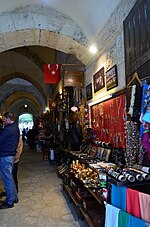
Under Ottoman rule, Tarsus initially formed part of the Eyalet of Aleppo. After the Ottoman conquest of Cyprus in 1571 it became the seat of a sanjak (sub-province) within the Cyprus Eyalet, before being transferred in 1608 to the sanjak of Adana as a kaza (district).[22]
Visiting in 1671 the traveller Evliya Çelebi recorded "a city on the plain, an hour from the sea, surrounded by strong walls two-storeys high, moated on all sides, with three distinct neighbourhoods inside the walls".
Despite its excellent defences, Tarsus was captured from the Ottomans in 1832 by the Mamluks of Ibrahim Pasha of Egypt, son of Muhammad Ali, and remained for eight years in Egyptian hands. The Egyptians began growing cotton on the surrounding plain. Following the return of Ottoman rule this cotton drove substantial growth in the local economy, due to increased world demand for the crop during shortages caused by the U.S. Civil War. A new road was built to the port in Mersin and the city of Tarsus grew and thrived. Still today many large houses in the city stand as reminders of the wealth generated during this period.
However, after 3,000 years as a flourishing port, by the end of the 19th century neglect Tarsus lost its access to the sea and the delta became a swamp. At this point it was a typical Ottoman city with communities of Muslim Turks, Christian Greeks and Armenians. With the founding of the Turkish Republic in the 1920s, the swamp was drained and the River Berdan was dammed to build Turkey's first hydro-electric power station. Irrigation, roadworks and a railway brought the economy of Tarsus back to life, with new factories particularly producing textiles.
Cuisine[edit]
The distinctive local cuisine includes chargrilled chicken hummus (sometimes heated and served with pastırma), şalgam (pickled turnips), tantuni (a sandwich of chopped grilled lamb), miniature pizzas (lahmacun) called "fındık lahmacun", and cezerye, a dessert made from carrots.
Sports[edit]
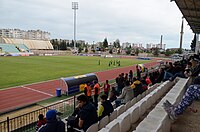
Tarsus has two football stadiums, Tarsus City Stadium and Burhanettin Kocamaz Stadium, and an arena, Tarsus Arena. The local football club is Tarsus Idman Yurdu.
Main sites[edit]
Tarsus city centre is home to the magnificent homes of wealthy traders, some of them restored, some still waiting a saviour. Additionally it is home to several historic sites although some are in need of restoration and research. These sites have been described by travellers for well over a century. For instance Blackwood's Magazine (Edinburgh) in 1890,[30] and H. V. Morton's In the Steps of St Paul in 1936.[31]
The best known include:
- Cleopatra's Gate – to the west of the city, the only ancient city gate still standing, where Antony and Cleopatra entered the city in 41 BC, though the "restoration" of this structure has covered much of it with shiny new stone (see [1] for a picture of the gate before the work was done).
- Roman bridge of Justinian over the Berdan River. It remains in good condition.
- Tarsus Museum, containing many ancient coins and a severed mummified arm
- Roman road north of Tarsus
- Ancient road another Roman road in the town centre
- Kızlar Kalesi, a medieval castle ruin
- Gözlükule - slight remains of original settlement mound
Sites of religious interest and pilgrimage include:
- St. Paul's Church and well (it is a museum, but occasionally Christian services take place here).
- Mosque said to be the burial place of the Prophet Daniel.
From the Turkish period:
Places of natural beauty include:
[edit]
- Mark Antony
- Cicero, Romanproconsul of Cilicia (51-50 BC)
- Cleopatra
- Paul the Apostle (Saul of Tarsus), Christian apostle, missionary, martyr, and saint, was born here and returned for a brief period later in life.
- Antipater, Stoic philosopher
- Archedemus of Tarsus, Stoic philosopher
- CaliphAl-Ma'mun died near Tarsus
- Chrysippus, Stoic philosopher
- Hagnon of Tarsus, rhetor and philosopher
- Hermogenes of Tarsus, rhetor
- Zeno of Tarsus, philosopher
- Lokman the Physician
- Saints Cyricus and Julitta
- Saint Nerses of Lambron, Archbishop of Tarsus in the Armenian Kingdom of Cilicia
- Saint Theodore of Tarsus, Archbishop of Canterbury.
- Tarsus is one of a number of cities that claims to be the burial place of Bilal ibn Rabah, first muezzin, or caller to prayer, in Islam.
- Former CEO of the Coca-Cola Company, Muhtar Kent, attended Tarsus American College
- Journalist Oral Çalışlar was born in Tarsus.
- Poet and author Ümit Yaşar Oğuzcan was born in Tarsus.
- Former judge and politician Emine Ülker Tarhan
- Çukurova Holding chairman Mehmet Emin Karamehmet
- Manuş Baba Turkish singer of Kurdish origin.
International relations[edit]
See also: List of twin towns and sister cities in Turkey
Tarsus is twinned with:
Gallery[edit]

Casemate of İbrahim Pasha


Tarsus American College, Stickler Building
Ruins of Makam-ı Danyal Mosque
Old Mosque converted from church

The cave of seven sleepers

Villages[edit]
See also[edit]
References[edit]
- ^"Population of province/district centers and towns/villages by districts - 2012". Address Based Population Registration System (ABPRS) Database. Turkish Statistical Institute. Retrieved 2013-02-27.
- ^Sirkeli Archaeological ProjectArchived 2009-01-05 at the Wayback Machine
- ^Suda, mu, 406
- ^Jonah 1:3 and the entry for Jonah in the Jewish Encyclopedia
- ^See The Lion of Venice: edited by Bianca Maria Scarfi (Venice. 1990) pp.101 & 110
- ^ abBosworth, C. E. (1992). "The City of Tarsus and the Arab-Byzantine Frontiers in Early and Middle ʿAbbāsid Times". Oriens. 33: 269. doi:10.1163/1877837292X00105. ISSN 0078-6527. JSTOR 1580607.
- ^Roger Collins, Early Medieval Europe 300-1000 (Basingstoke, Hampshire: Palgrave Macmillan, 1999) p. 40.,
- ^Acts 9:11
- ^Acts 22:3
- ^"I am verily a man which am a Jew, born in Tarsus, a city in Cilicia, yet brought up in this city at the feet of Gamaliel, and taught according to the perfect manner of the law of the fathers, and was zealous toward God, as ye all are this day." --Acts 22:3
- ^Edwards, Robert W., "Tarsus" (2016). The Eerdmans Encyclopedia of Early Christian Art and Archaeology, ed., Paul Corby Finney. Grand Rapids, Michigan: William B. Eerdmans Publishing. pp. 569–570. ISBN .
- ^ abcdFoss, Clive (1991). "Tarsos". In Kazhdan, Alexander (ed.). The Oxford Dictionary of Byzantium. New York and Oxford: Oxford University Press. p. 2013. ISBN .
- ^Eusebius, Ecclesiastical History, VI, xlvi; VII, v.
- ^ abLe Quien, Michel (1740). "Ecclesia Tarsensis". Oriens Christianus, in quatuor Patriarchatus digestus: quo exhibentur ecclesiæ, patriarchæ, cæterique præsules totius Orientis. Tomus secundus, in quo Illyricum Orientale ad Patriarchatum Constantinopolitanum pertinens, Patriarchatus Alexandrinus & Antiochenus, magnæque Chaldæorum & Jacobitarum Diœceses exponuntur (in Latin). Paris: Ex Typographia Regia. cols. 869–876. OCLC 955922747.
- ^
 Herbermann, Charles, ed. (1913). "Tarsus". Catholic Encyclopedia. New York: Robert Appleton Company.
Herbermann, Charles, ed. (1913). "Tarsus". Catholic Encyclopedia. New York: Robert Appleton Company. - ^Annuario Pontificio 2013 (Libreria Editrice Vaticana, 2013, ISBN 978-88-209-9070-1), p. 984
- ^Eusebius, Historia Ecclesiastica, VI, xlvi; VII, v). Le Quien (Oriens christianus, II, 869-76)
- ^Michael the Syrian :89.
- ^Michael the Syrian :102.
- ^ abcdLe Quien, Michel (1740). "Ecclesia Tarsi". Oriens Christianus, in quatuor Patriarchatus digestus: quo exhibentur ecclesiæ, patriarchæ, cæterique præsules totius Orientis. Tomus secundus, in quo Illyricum Orientale ad Patriarchatum Constantinopolitanum pertinens, Patriarchatus Alexandrinus & Antiochenus, magnæque Chaldæorum & Jacobitarum Diœceses exponuntur (in Latin). Paris: Ex Typographia Regia. cols. 1465–1468. OCLC 955922747.
- ^Bosworth, C. E. (1992). "The City of Tarsus and the Arab-Byzantine Frontiers in Early and Middle ʿAbbāsid Times". Oriens. 33: 269–270. doi:10.1163/1877837292X00105. ISSN 0078-6527. JSTOR 1580607.
- ^ abcBosworth, C. E. (2000). "Ṭarsūs". In Bearman, P. J.; Bianquis, Th.; Bosworth, C. E.; van Donzel, E. & Heinrichs, W. P. (eds.). The Encyclopaedia of Islam, Second Edition. Volume X: T–U. Leiden: E. J. Brill. pp. 306–307. ISBN .
- ^Bosworth, C. E. (1992). "The City of Tarsus and the Arab-Byzantine Frontiers in Early and Middle ʿAbbāsid Times". Oriens. 33: 271–273. doi:10.1163/1877837292X00105. ISSN 0078-6527. JSTOR 1580607.
- ^Bosworth, C. E. (1992). "The City of Tarsus and the Arab-Byzantine Frontiers in Early and Middle ʿAbbāsid Times". Oriens. 33: 273–274. doi:10.1163/1877837292X00105. ISSN 0078-6527. JSTOR 1580607.
- ^Bosworth, C. E. (1992). "The City of Tarsus and the Arab-Byzantine Frontiers in Early and Middle ʿAbbāsid Times". Oriens. 33: 270–271. doi:10.1163/1877837292X00105. ISSN 0078-6527. JSTOR 1580607.
- ^Bosworth, C. E. (1992). "The City of Tarsus and the Arab-Byzantine Frontiers in Early and Middle ʿAbbāsid Times". Oriens. 33: 274–276. doi:10.1163/1877837292X00105. ISSN 0078-6527. JSTOR 1580607.
- ^Bosworth, C. E. (1992). "The City of Tarsus and the Arab-Byzantine Frontiers in Early and Middle ʿAbbāsid Times". Oriens. 33: 276–278. doi:10.1163/1877837292X00105. ISSN 0078-6527. JSTOR 1580607.
- ^Miles, George C. (1957). "Islamic coins from the Tarsus excavations of 1935-1937". The Aegean and the Near East, Studies presented to Hetty Goldman. New York. pp. 297–312.
- ^Stern, S. M. (1960). "The Coins of Thamal and of Other Governors of Tarsus". Journal of the American Oriental Society. 80 (3): 217–225. doi:10.2307/596170. JSTOR 596170.
- ^Bent J T. Tarsus – Past and Present. Blackwood's Magazine (Edinburgh) Volume 148, 1890 pp 616-625
- ^H. V. Morton. In the Steps of St Paul, London: Rich & Cowan, 1936
External links[edit]
SOĞUTMA
Eksen teknolojili fan tasarımı ile standart bir fan arasındaki hava akışı karşılaştırması.
Eksen Teknolojili Fan Tasarımı
Daha İyi, Daha Hızlı, Daha Güçlü
Performansı kanıtlanan iki adet eksen teknolojili fan, daha uzun kanatlara yer verebilen küçük bir yuvaya ve aşağı yönlü hava basıncını artıran bir bariyer halkasına sahip.
Dönen bir fan sıcaklık 55 Santigrat'ı gösterdiğinde durmak için yavaşlıyor.
0dB Teknolojisi
Sessiz Zeka
GPU çekirdek sıcaklığı 55 derecenin altına düştüğünde gelişmiş dahili kontrolcü fanları durdurur. Böylece oyun keyfini sessiz bir ortamda yaşayabilirsiniz. Sıcaklık belirli eşiği geçtiğinde fanlar otomatik olarak çalışmaya başlar.

Çift Rulmanlı Fanlar
2 Kat Daha Uzun Ömür
Farklı yatak biçimlerinin kendilerine özgü artı ve eksileri vardır. Çift rulmanlı yataklar kaymalı yataklı tasarıma göre iki kat daha uzun ömürlüdür.
MÜHENDİSLİK
Auto-Extreme teknolojisini açıklayan video.
Auto−Extreme Teknolojisi
Hassas otomatik üretim
Auto-Extreme Teknolojisi, endüstride yeni standartlar belirleyen ve tüm lehim işlemlerinin tek seferde yapılmasını sağlayan bir otomatik üretim sürecidir. Bu süreç, bileşenler üzerindeki termal zorlanmayı azaltır ve güçlü temizlik kimyasallarının kullanılmasını önler. Sonuç olarak doğaya daha az etki eden, üretimde güç tüketimini azaltan, daha güvenilir bir ürün ortaya çıkar.

Koruyucu Arka Plaka
Tamamen metal!
PCB, yapısal sağlamlık katan bir alüminyum arka plakayla güçlendirildi. Bu, plakanın bükülmesini önler, bileşenleri ve iletken hatları hasara karşı korur.
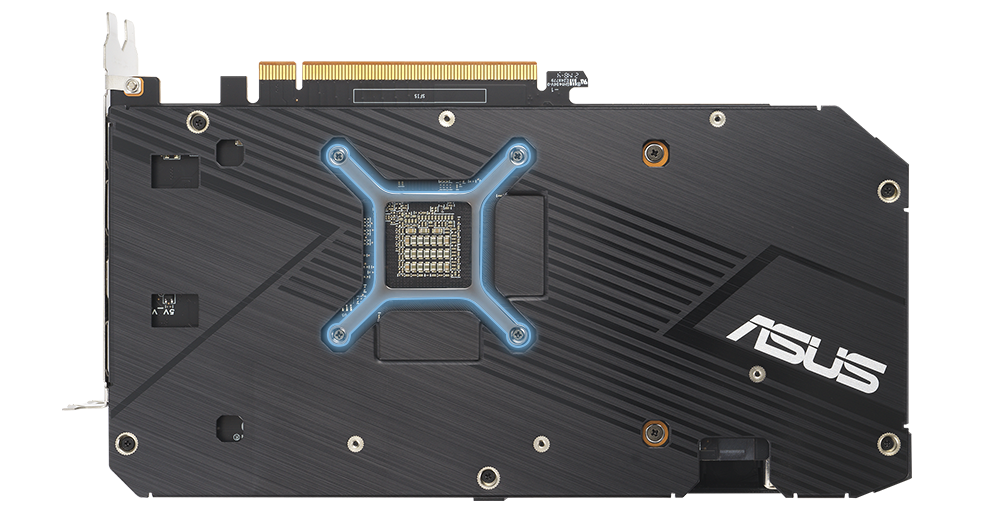
GPU Braketi
Tamamen Hazır
GPU yuvası, kartı yerleştirirken uygulanan basıncı homojen şekilde dağıtır. Ayrıca, yonga ve ısı dağıtıcısı arasındaki kritik bağlantıya dayanıklılık katar.
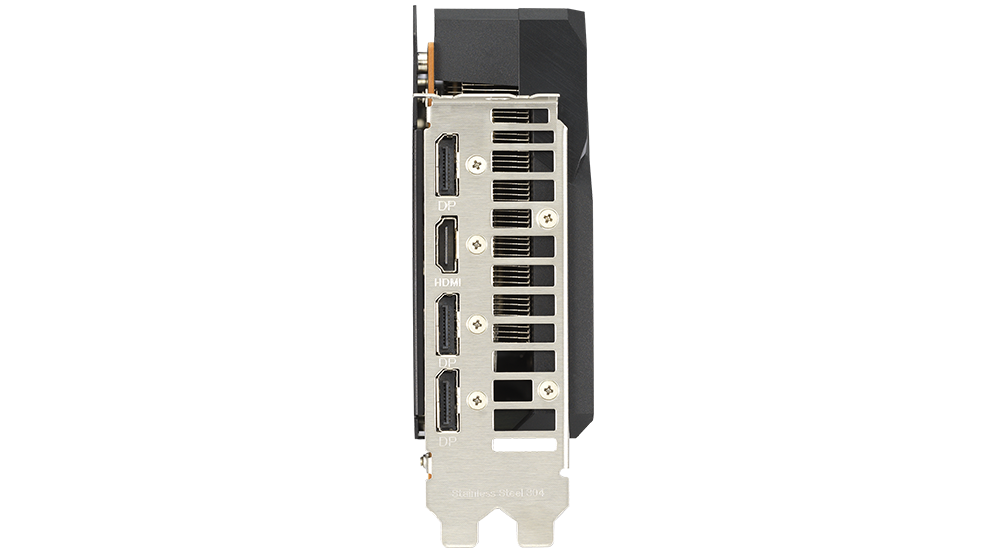
Paslanmaz Çelik Braket
Çelik koruma
Dual’ın montaj braketi, daha sert ve korozyona karşı daha dayanıklı olan 304 Paslanmaz Çelik ile güçlendirilmiştir.
YAZILIM

GPU TWEAK III
Takip et ve ayarla
ASUS GPU Tweak III aracı, ekran kartı performans ayarlarını bir üst seviyeye taşır. Bu araç; GPU çekirdek saat hızları, bellek frekansı, voltaj ayarları gibi birçok kritik ayarı yapmanızı ve özelleştirilebilir bir arayüz üzerinden her şeyi gerçek zamanlı olarak takip etmenizi mümkün kılar. Kartınızdan en iyi şekilde yararlanmanıza yardımcı olacak çok sayıda özellik arasında gelişmiş fan kontrolü de bulunur.
GPU Tweak III hakkında daha fazla bilgi edinin >
AMD Yazılımı
Oyun tarzınızı değiştirin
En yeni AMD yazılımı, yeni oyun sürümleri ve kişiselleştirilebilir oyun deneyimi için optimize edilmiş güncel sürücüler ile grafik işlemcinizin tam potansiyelini ortaya çıkarır.

QuantumCloud
GPU'nun gücüyle kar edin
Quantumcloud boşta duran GPU’nuzu çalıştırarak zahmetsizce ekstra para kazanmanızı sağlayan basit ve güvenli bir hizmettir. Kazandıklarınız otomatik olarak WeChat veya PayPal hesabınıza aktarılır. Ayrıca, QuantumCloud’da Steam’in de dahil olduğu birden fazla ödeme yöntemi mevcut. Bunlara ek olarak, QuantumCloud hiçbir kişisel verinizi saklamadığından gizliliğiniz de bozulmaz. Şimdi para kazanmaya başlayın!
Learn more about QuantumCloud >DENEYİM

144-hour Validation Program
"Extensive" may be an understatement
A 144-hour validation program puts cards through a series of stringent tests to ensure compatibility with the latest games.

NVIDIA® G-SYNC®
Smooth operator
This graphics card supports NVIDIA® G-SYNC® display technology for a super-smooth variable refresh rate experience. Enjoy AAA games without the nuisance of screen tearing or stuttering.

Güç Kaynağınızı Seçin
Voltaj hesaplayıcımızı kullanarak sisteminizi beslemek için ortalama ne kadar güce ihtiyaç duyacağınızı görün ve üstün performans için ROG Thor, ROG Loki veya ROG Strix AURA gibi uyumlu PSU’lardan birini seçin.
Daha fazla bilgi >
1 Ay Ücretsiz Adobe Creative Cloud
Belirli ASUS ürünlerinden satın alın ve ücretsiz abonelik kazanın.*

20+ Adobe Uygulaması
Photoshop, Illustrator, InDesign, Spark ve XD gibi sektöre lideri uygulamalar.
Adobe Fonts
Creative Cloud uygulamalarınızda binlerce yazı türüne erişim.
Behance
Dünyanın en büyük kreatif topluluğunda ilham kaynağınızı bulun.
Creative Cloud Arşivleri
Ekibiniz işleri uygulamalarda ve cihazlarda paylaşabilir, böylece herkes işleri takip edebilir.
Her kullanıcıya 1TB bulut depolama
Ekstra depolama alanıyla kreatif işlerinizi ekibinizle kolayca paylaşıp yönetebilirsiniz.
Daha Fazla Bilgi >Kayıt Ol >
*Hüküm ve koşullar geçerlidir. Daha fazla bilgi için lütfen etkinlik sayfasındaki hüküm ve koşulları okuyun.
Oyun Oyna, Yayın Yap ve Harekete Geç.
AMD RDNA™ 3 mimarisi ile güçlendirilen AMD Radeon™ RX 7600 ekran kartıyla 1080p çözünürlükte oyun ve yayın deneyimi için benzersiz performansı, görüntüleri ve verimliliği deneyimleyin. AMD Radiance Display™ Engine’in sağladığı yüksek renk doğruluğuyla nefes kesici görüntülere kendinizi kaptıracaksınız. AMD FidelityFX™ Super Resolution ve Radeon™ Super Resolution ölçekleme teknolojisiyle kare hızlarını artırın.1. Daha fazla performans için AMD Radeon™ RX 7000 Serisi ekran kartlarını uyumlu AMD Ryzen™ işlemcilerle birleştirerek AMD Smart teknolojilerini etkinleştirin.3

ÇIĞIR AÇAN PERFORMANS
AMD Radeon™ RX 7600 ekran kartı oyuncular ve yayıncılar için yeni bir performans seviyesi belirliyor. Homojen AMD RDNA™ 3 işleme birimleri ve ışık hızında saat hızları ile 1080p çözünürlükte yüksek yenileme hızlarını ortaya çıkarır.

NEFES KESEN GÖRÜNTÜLER
Olağanüstü bir performansla birinci sınıf görüntüler sunan hesaplama tabanlı AMD FidelityFX™ ve ölçekleme teknolojilerinin bir birleşimiyle yüksek performanslı ultra hızlı oyun deneyimini ve yeni seviyedeki netliği keşfedin. AMD Radiance Display™ Engine ve DisplayPort™ 2.1’in sunduğu 8K’ya varan çözünürlükte 68 milyara varan renk ve 165Hz yenileme hızıyla kendinizi görüntülere daha faza kaptıracaksınız. Yayın yaparken daha iyi ve daha net görüntüler için gelişmiş encoder’lar, entegre yapay zeka ve içeriğe göre uyarlanan makine öğrenmesi teknolojileriyle birlikte izleyicilerinize gelişmiş görsel kalite sunun.

BİRLİKTE DAHA GÜÇLÜ
AMD Smart teknolojilerini etkinleştirmek için AMD Radeon™ RX 7600 ekran kartlarını ve AMD Ryzen™ işlemcilerini birleştirin. Oyunlarda üstünlüğe sahip olmak için olağanüstü performansı açığa çıkarabilirsiniz. AMD Software ile AMD Radeon™ RX 7000 Serisi Ekran kartınızı geliştirin. En iyi oyun deneyimi için Adrenalin Edition™ uygulaması sağlam sürücüler barındırır.

PERFORMANSI YÜKSELTİN, NETLİĞİ ZİRVEYE ÇIKARIN
AMD FidelityFX™ Super Resolution teknolojisi1, ölçekleme teknolojisini yeni seviyeye taşır. Desteklenen oyunlarda kare hızlarını artırırken inanılmaz görüntü kalitesi sağlar. AMD Radeon™ Super Resolution (RSR)2, sürücü düzeyinde FSR teknolojisinden yararlanarak size binlerce oyunda ölçeklenmiş performans avantajları sunar.



